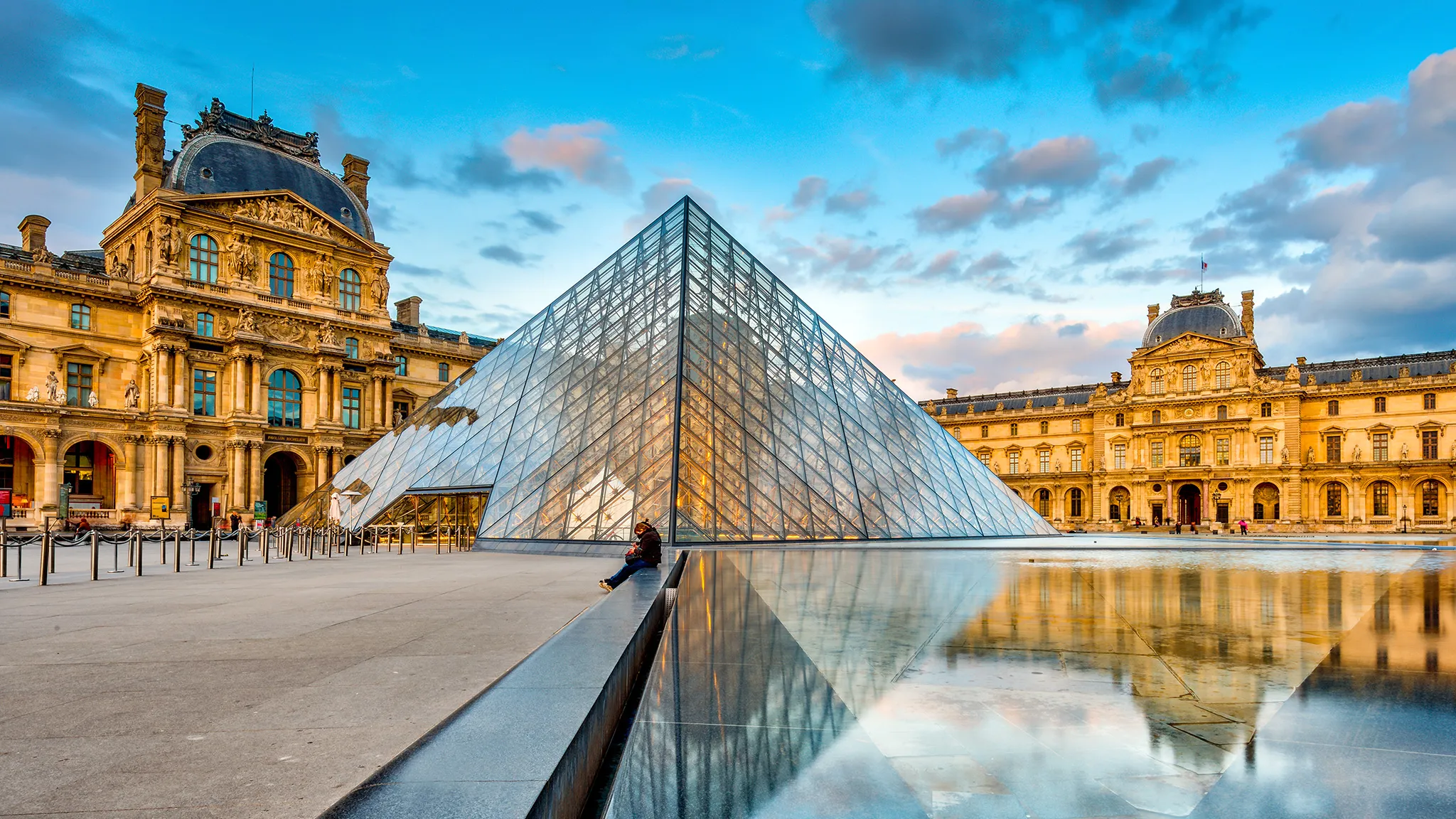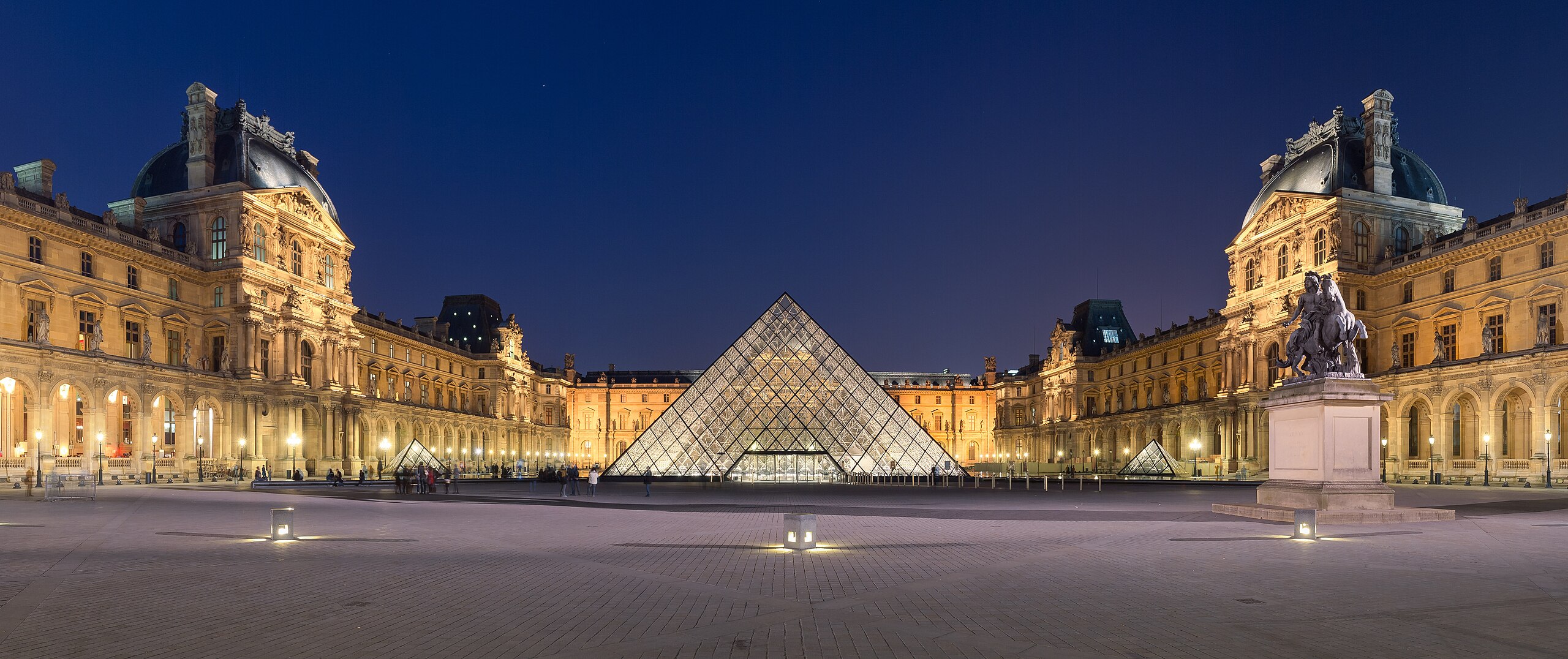The Louvre Museum, located in the heart of Paris, stands as a testament to human creativity, ingenuity, and cultural heritage. Home to thousands of works of art spanning millennia, the Louvre is not merely a museum but a beacon of civilization, drawing millions of visitors from around the globe each year. In this article, we embark on a journey to discover the wonders housed within the walls of the Louvre Museum.
Exploring the Magnificence of the Louvre Museum

Louvre Museum
A Palace of Art and History:
Originally built as a fortress in the 12th century, the Louvre evolved over the centuries into a grand palace, eventually becoming a museum in 1793 during the French Revolution. Its rich history is reflected in its architecture, from the medieval foundations to the Renaissance façades and the iconic glass pyramid added in the 1980s.
Masterpieces of Antiquity:
The Louvre Museum boasts an unparalleled collection of antiquities from civilizations across the globe. Visitors can marvel at ancient Egyptian artifacts, including the famed Sphinx and the majestic statues of pharaohs. Greek and Roman sculptures, such as the Venus de Milo and the Winged Victory of Samothrace, offer glimpses into the artistry and ideals of classical antiquity.
European Treasures:
The Louvre is renowned for its extensive collection of European paintings, spanning the Middle Ages to the 19th century. Visitors can admire iconic works such as Leonardo da Vinci’s “Mona Lisa,” Michelangelo’s “Dying Slave,” and Delacroix’s “Liberty Leading the People.” Each painting tells a story, capturing moments of triumph, tragedy, and timeless beauty.
Islamic Art and Culture:
In addition to its European holdings, the Louvre houses a remarkable collection of Islamic art and artifacts. From intricate carpets and ceramics to stunning examples of calligraphy and metalwork, these treasures offer insights into the diversity and richness of Islamic culture spanning centuries and continents.
Cultural Icon and Global Destination:
The Louvre Museum is not merely a repository of art but a cultural icon and global destination. Its exhibitions, events, and educational programs attract visitors of all ages and backgrounds, fostering dialogue, understanding, and appreciation for the world’s cultural heritage.
Preserving the Past, Inspiring the Future:
As one of the world’s largest and most visited museums, the Louvre plays a vital role in preserving the past and inspiring future generations. Through conservation efforts, research, and outreach initiatives, the Louvre ensures that its treasures continue to enrich and enlighten humanity for centuries to come.
The Louvre Museum stands as a beacon of human creativity, history, and cultural heritage. From its magnificent architecture to its unparalleled collections, the Louvre invites visitors to embark on a journey through time and space, exploring the wonders of civilization and the enduring power of art. As a symbol of human achievement and aspiration, the Louvre continues to inspire awe and wonder, reminding us of the boundless potential of the human spirit.
Exploring the Pros and Cons of the Louvre Museum
The Louvre Museum, an iconic cultural institution located in the heart of Paris, stands as a symbol of human creativity, history, and artistic achievement. Home to an extensive collection of priceless treasures spanning millennia, the Louvre attracts millions of visitors each year. While it boasts numerous strengths, the museum also faces challenges and limitations. In this article, we delve into the advantages and disadvantages of the Louvre Museum.

Louvre Museum
Advantages:
- Rich Cultural Heritage: The Louvre Museum houses one of the most extensive and diverse collections of art and artifacts in the world, spanning ancient civilizations, European masterpieces, Islamic art, and more. Its vast array of treasures provides visitors with a comprehensive overview of human history, culture, and creativity.
- Iconic Masterpieces: Visitors to the Louvre have the opportunity to view iconic masterpieces up close, including Leonardo da Vinci’s “Mona Lisa,” the Venus de Milo, and the Winged Victory of Samothrace. These artworks are celebrated for their beauty, historical significance, and cultural impact, offering visitors a profound and unforgettable experience.
- Educational Opportunities: The Louvre Museum offers a wide range of educational programs, guided tours, and exhibitions aimed at enriching visitors’ understanding of art, history, and culture. These initiatives cater to diverse audiences, from school groups to scholars, fostering learning, dialogue, and appreciation for the arts.
- Architectural Splendor: In addition to its world-class collections, the Louvre is renowned for its architectural splendor, blending medieval fortifications with Renaissance grandeur and modern innovations such as the iconic glass pyramid. The museum’s architecture adds to its allure, creating a memorable and visually stunning environment for visitors.
Disadvantages:
- Crowds and Queues: The popularity of the Louvre Museum often results in large crowds and long queues, particularly during peak tourist seasons. Navigating through the museum can be challenging, leading to overcrowding in popular galleries and limiting the time visitors have to appreciate the artwork.
- Limited Accessibility: Despite efforts to improve accessibility, the sheer size and complexity of the Louvre Museum can present challenges for visitors with mobility issues or disabilities. Certain areas of the museum may be inaccessible or difficult to navigate, restricting access to some of its collections.
- Conservation Concerns: The Louvre’s extensive collections require meticulous care and conservation to preserve them for future generations. However, limited resources and funding constraints can pose challenges to maintaining and safeguarding the museum’s treasures, leading to issues such as deterioration and damage over time.
- Cultural Sensitivity: The Louvre’s collections include artifacts and artworks from diverse cultures and civilizations, raising questions about cultural sensitivity, ownership, and restitution. Debates surrounding the repatriation of looted or stolen artifacts underscore the ethical challenges faced by the museum and the broader museum community.
The Louvre Museum offers a wealth of cultural riches and educational opportunities, making it a must-visit destination for art lovers and history enthusiasts worldwide. While it boasts numerous advantages, including its rich collections, iconic masterpieces, and architectural splendor, the museum also faces challenges such as crowds, accessibility issues, conservation concerns, and ethical dilemmas. By addressing these challenges while capitalizing on its strengths, the Louvre can continue to fulfill its mission of preserving and promoting the world’s cultural heritage for generations to come.
Exploring the Louvre Museum: A Comprehensive Review
The Louvre Museum, situated in the heart of Paris, stands as an epitome of art, culture, and history, drawing millions of visitors from across the globe each year. With its vast collection spanning centuries and continents, the Louvre offers an unparalleled cultural experience. In this comprehensive review, we delve into the various aspects of the Louvre Museum, examining its strengths, weaknesses, and overall impact on visitors.

Louvre Museum
1. Collection and Exhibits:
The Louvre Museum boasts an extensive and diverse collection of artworks and artifacts, ranging from ancient civilizations to modern masterpieces. Visitors can explore Egyptian antiquities, Greek and Roman sculptures, European paintings, Islamic art, and much more. The museum’s exhibits are meticulously curated, providing insights into different cultures, artistic movements, and historical periods.
2. Iconic Masterpieces:
One of the highlights of the Louvre Museum is its collection of iconic masterpieces that have captivated audiences for centuries. Visitors flock to see Leonardo da Vinci’s enigmatic “Mona Lisa,” the majestic “Venus de Milo,” and the awe-inspiring “Winged Victory of Samothrace.” These artworks showcase the pinnacle of human creativity and artistic achievement, leaving a lasting impression on all who behold them.
3. Architecture and Ambiance:
The Louvre’s architecture is a blend of old and new, with its historic palace wings juxtaposed against modern additions such as the iconic glass pyramid. The grandeur of the museum’s architecture sets the stage for an immersive cultural experience, creating a sense of awe and wonder as visitors explore its vast halls and galleries.
4. Visitor Experience:
Navigating the Louvre Museum can be a pwvip4d daunting task due to its sheer size and popularity. Long queues, crowded galleries, and navigation challenges are common issues faced by visitors, particularly during peak tourist seasons. However, the museum’s well-designed audio guides, guided tours, and interactive exhibits enhance the visitor experience, providing valuable insights and context to the artworks on display.
5. Accessibility and Amenities:
The Louvre Museum strives to cater to visitors of all ages and abilities, offering accessibility services such as wheelchair rentals, elevators, and designated rest areas. However, accessibility remains a challenge in certain areas of the museum, and improvements could be made to ensure a more inclusive experience for all visitors.
6. Conservation and Preservation:
Preserving the Louvre’s vast collection requires ongoing conservation efforts and expertise. While the museum employs dedicated conservation teams, limited resources and funding constraints can pose challenges to the long-term preservation of its artworks and artifacts. Continued investment in conservation initiatives is crucial to safeguarding the cultural heritage housed within the museum.
7. Cultural Impact and Legacy:
The Louvre Museum’s cultural impact extends far beyond its walls, shaping global perceptions of art, history, and civilization. Its exhibitions, educational programs, and outreach initiatives foster dialogue, understanding, and appreciation for diverse cultures and artistic traditions. The museum’s legacy as a guardian of human creativity and heritage will endure for generations to come.
Conclusion:
In conclusion, the Louvre Museum offers a multifaceted cultural experience that celebrates the diversity and richness of human creativity. While it faces challenges such as visitor congestion and conservation issues, its unparalleled collection, iconic masterpieces, and cultural significance make it a must-visit destination for art enthusiasts and history lovers alike. As a beacon of art, culture, and history, the Louvre continues to inspire and captivate audiences from around the world, leaving an indelible mark on the fabric of human civilization.
Read More Article About “Intel and AMD Shock: China’s Urgent Shift to Supercharge“



